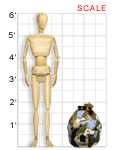VAM galleries including this work:
Kentucky Museum of Art and Craft | World of the Spirit || VAM Home
Wayne Ferguson, (Kentucky, b. 1946)
DANIEL IN THE LION’S DEN, 1985
Glazed stoneware; 20" X 21"
Kentucky Museum of Art and Craft
This ceramic piece by Wayne Ferguson is an example of both sculptural and narrative art. While it may seem like a rather ordinary work in clay from the outside, the vessel is perforated by small viewing holes, which when looked through reveal the figures of Daniel and several lions on the inside. Curious monkeys cling to the outside lip of the vessel, watching the scene below them with interest. The outside of the vessel also features areas that whistle when blown through. This piece relates the biblical tale of Daniel; Biblical and religious themes are common in the work of Southern folk artists.
About the Artist
Wayne Ferguson recalls playing with clay that his mother mixed from flour, salt, and food coloring while he was growing up in Whitley County, Kentucky. That was Wayne’s first taste of the medium, and he hasn’t stopped working with clay since.
Ferguson refined his artistic ability as a student at the University of Kentucky, where he was able to experiment with a variety of pottery techniques. Over the past 30 years, he has developed one of the most distinctive styles among Kentucky ceramic artists with his trademark sense of humor and whimsical animal forms. His ceramic whistles are favorites with collectors, and he often adds whistles to his other works.
“Clay enables me to create entities which communicate or tell stories.”
Pottery is a vehicle of communication for Ferguson. He often uses his work to express his reactions to external influences, which range from issues of unsatisfactory AIDS education and environmental concerns to the simple act of catching a fish. Clay “enables me to create entities which communicate or tell stories,” he says. “As an artist, the communication factor is important.” Ferguson shares his knowledge, skills, and enthusiasm for ceramic arts with students of all ages and abilities.
Note: Wayne Ferguson discusses his work in the Visual Arts Toolkit video segment “Ceramics: Wayne Ferguson” on Through Artists’ Eyes: Exploring the Creative Process. He also is featured in the video segment “The Artist’s Point of View, Part 2” on Responding to Visual Art.
Classroom Ideas
Discussion: Describe this piece. How did Ferguson use the elements of art in it? Read the story of Daniel in the lion’s den. Does Ferguson’s work convey the story well? Why do you think the artist chose to re-create this story in clay? Why do you think he placed the characters inside the vessel with only small viewing windows? What is your opinion of this piece? Support your answer with specific details that reference the work. What do you think about the fact that there are whistles on the sides of the vessel? How else are whistles used in work and play?
Activities: Research how to make a ceramic whistle and make one showing an animal or shape that appeals to you.
Retell a favorite story using pictures instead of words. Then re-create a scene from your story in clay bookends.
Directions for making the bookends:
- Starting with about three pounds of clay, wedge it to get out any air bubbles.
- Roll two slabs from the clay. Measure your slabs with a ruler to make sure each is roughly 14" long, 7" wide, and 3/4" thick.
- Using the ruler to measure, cut out a rectangle that is 12" or 13" long by about 6" wide from each slab, making each of them into an L shape. Lift the ends of the slabs and lean them against something steady for support.
- Using the story in pictures that you created earlier as a guide, it’s time to build this scene “inside” the L. Be sure to slip and score the clay when attaching separate pieces. If necessary, use your fingers or a damp sponge to smooth out any cracks.
- Have your bookends bisque-fired, then glaze or paint your pieces.
When you have finished, write an artist’s statement about the piece you made. You can include biographical information, sources of inspiration, and details about the work. Display your bookend and your artist’s statement together.
Links
You’ll find instructions for making ceramic whistles at these sites:
- Princeton Online’s Incredible @rt Department
[www.princetonol.com/groups/iad/Files/whistle.htm] - How To Make a Clay Whistle by Dwight Bartholomew
[www.geocities.com/RainForest/Canopy/2525/whistles/whistle.html] - Ceramics Today
[www.ceramicstoday.com/articles/clay_whistle.htm]
See other ocarinas and read more about them at The Whistle Press.
[www.whistlepress.com]
Read a summary of the Biblical story of Daniel in the Lion’s Den from Just4Kids Magazine.
[www.just4kidsmagazine.com/rainbowcastle/daniel.html]


